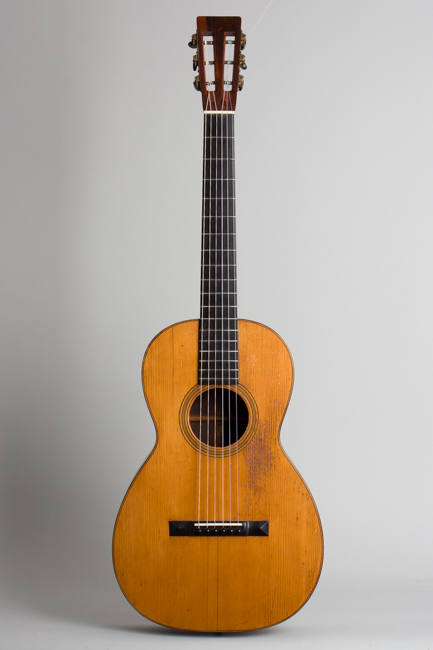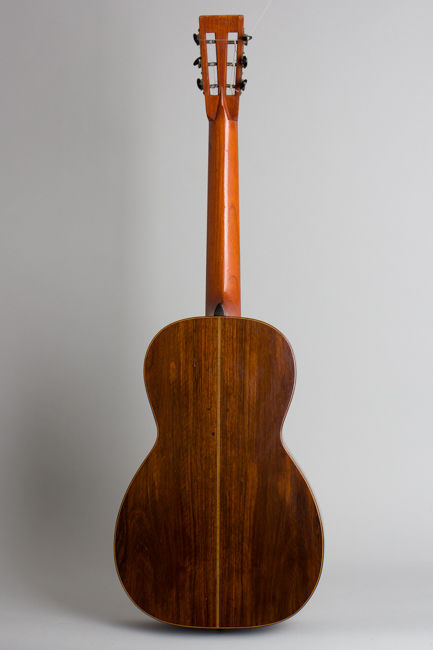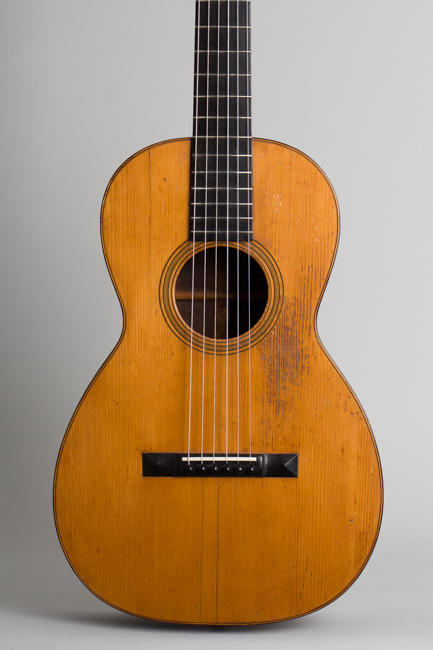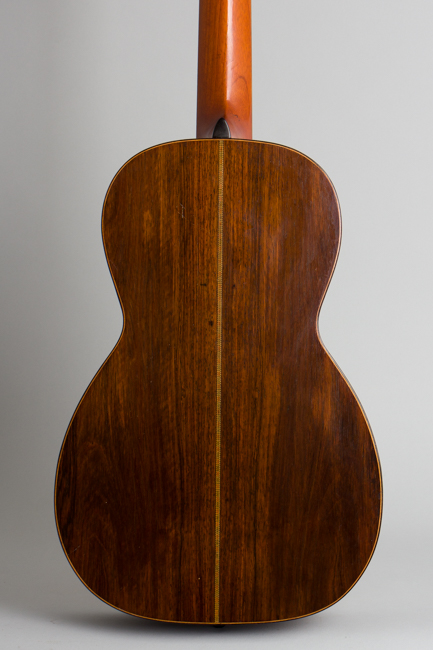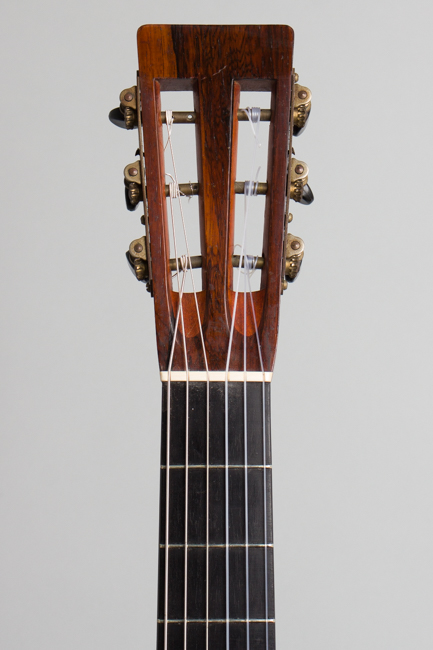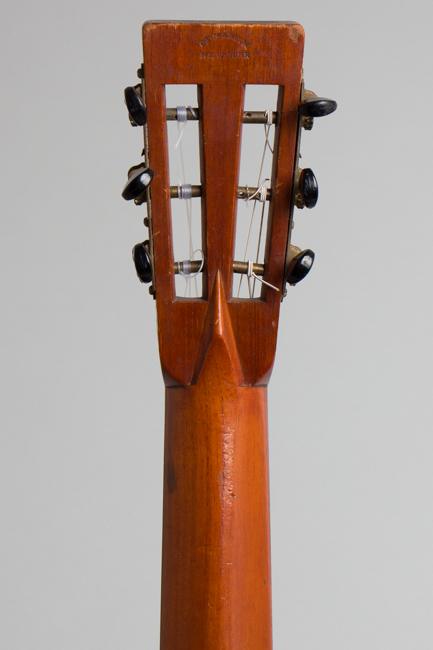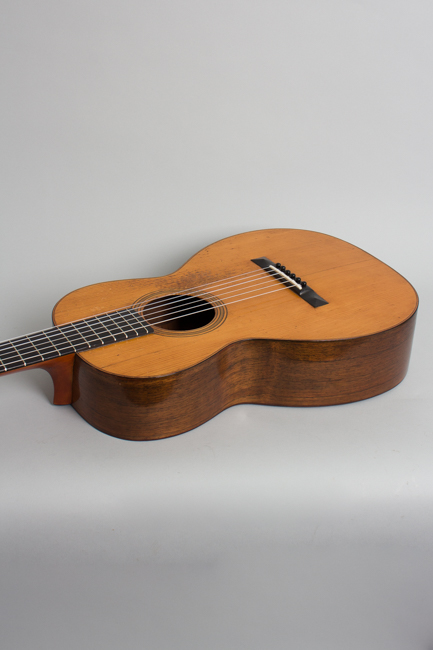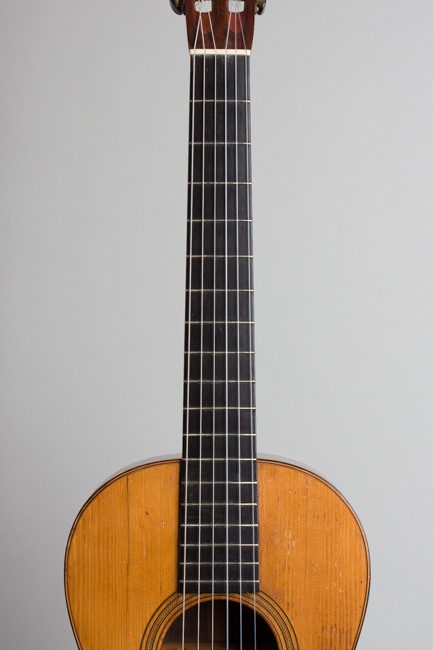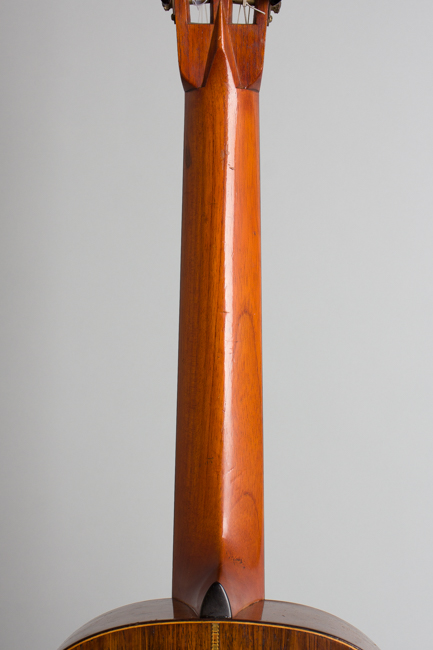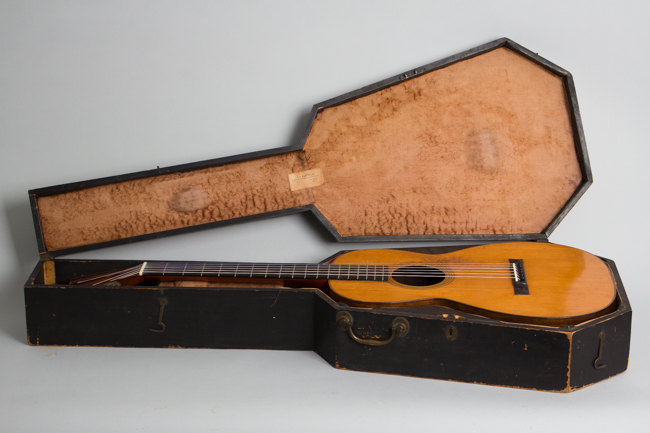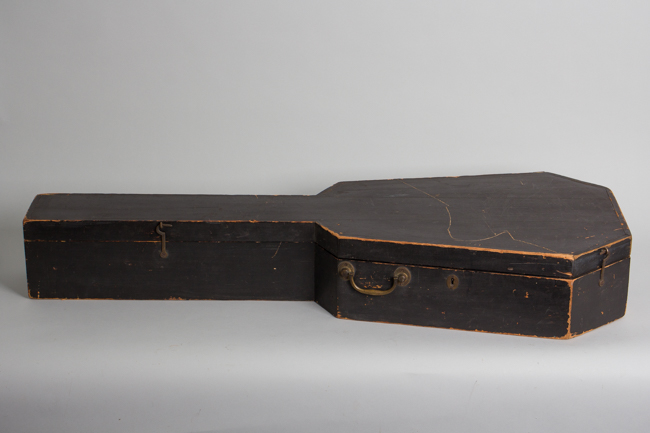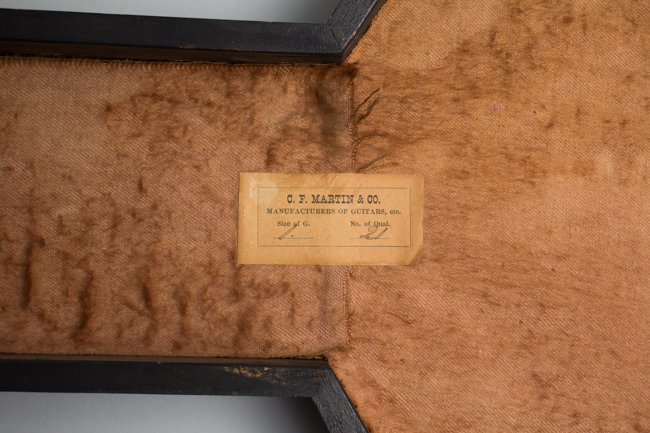C. F. Martin 1-21 Flat Top Acoustic Guitar , c. 1880
This item is currently on hold.
Item # 11689
Prices subject to change without notice.
C. F. Martin 1-21 Model Flat Top Acoustic Guitar, c. 1880, made in Nazareth, PA, natural varnish finish, Brazilian rosewood back and sides, spruce top; cedar neck with ebony fingerboard, original black coffin case.
The Martin Style 1-21 is one of the company's more venerable styles dating way back to the 1850s. This was considered a midline rosewood model and was fairly popular through the latter part of the 19th century. Although the under-13" size "1" is considered a very small guitar today, before 1854 it was the largest size Martin made. The Style 21 is primarily distinguished by its herringbone soundhole rosette, with plain wood trim around the body edge. The now more famous Style 28 is trimmed along the top with herringbone, and for much of the 20th century the 21 was seen as sort of a second choice, the cheapest rosewood guitar Martin offered. That was not the case when this one was built around 1880; Martin's line was more extensive and the 21 sat solidly in the middle.
This guitar still resides in the original coffin case with the Martin label under the lid confirming its designation as a 1-21; recent research dates this particular label between 1875 and 1886.The guitar itself does not appear to have any visible internal dating marks. The rosewood body has some lovely figure, especially on the back. The red spruce top is very delicately braced with the traditional scalloped X pattern . The cedar neck has a fairly shallow soft "V" profile, topped with a plain unmarked ebony fingerboard fitted with the traditional Martin bar frets. The C.F. Martin stamp is visible on the back of the headstock, the backstrip and on the heelblock, where it was stamped upside down.
With close to 150 years under it's belt, this little wonder has seen a lot of use but escaped unnecessary alteration and avoided the often catastrophic damage caused when these were often steel-strung starting even in the 1920s. This beautifully made and delicately X-braced guitar like all Martins from this era is suited to gut or nylon strings ONLY. It is a lovely and stately guitar that wears its scars proudly and still sings beautifully with a robust and surprisingly powerful sound.
Overall length is 38 in. (96.5 cm.), 12 7/8 in. (32.7 cm.) wide at lower bout, and 4 1/4 in. (10.8 cm.) in depth at side, taken at the end block. Scale length is 24 3/4 in. (629 mm.). Width of nut is 1 13/16 in. (46 mm.).
This charming nearly century-and-a-half old guitar is still a lovely player, a real testament to the care and craftsmanship that has always been the hallmark of the C.F Martin & Co. organization. The guitar has preserved much of its originality over the decades, though there have been a number of typical repairs. The original finish does show a decent amount of wear especially on the top with heavier strum marks below the sound hole, going into the wood from the waist back on the treble side. There are a number of nicks, dings and scrapes scattered over the instrument.
The top also shows the most repair with two long spruce grain splits below the bridge running to the back edge which have been glued but not finished over. The more obvious along the center seam. A shorter tighter grain split is just below these, also running back from the bridge but not to the edge. Another grain split runs back from the forward edge of the top on the bass side above the soundhole, almost perfectly mirrored by one below that is more tightly closed up. The top center seam has also been resealed between the bridge and soundhole. There are only minimal cleating related to these repairs.
The back has a few very tightly sealed inconspicuous grain splits that have been sealed but not cleated. The lower side has one tiny grain split on the waist and a small resealed area of wood binding just above the heel. The guitar has had the neck reset, with some original bar frets reworked and re-installed after the fingerboard was trued. The fingerboard has a couple of scars above the body from this process. Unfortunately the original tuners appear to have been lost long ago, and the guitar is fitted with Waverly strips from the 1950s.
The original ebony pyramid-end bridge has been reglued with less disturbance around the edge than many. It is fitted with a newer bone saddle; the original delicate ivory one is preserved in the case. Internally the tiny original bridge plate and delicate scalloped bracing remain intact, with two added cleats beneath the center seam the only addition. The guitar is an excellent player and a wonderful trip back to the 19th century, an authentic playable museum piece and simply a delightful featherweight guitar. The original black-painted wooden coffin case is also beautifully made, still fully functional and more intact than most with some typical wear. The name "Williamson" is hand-etched in script into the top end. Overall Very Good + Condition.
The Martin Style 1-21 is one of the company's more venerable styles dating way back to the 1850s. This was considered a midline rosewood model and was fairly popular through the latter part of the 19th century. Although the under-13" size "1" is considered a very small guitar today, before 1854 it was the largest size Martin made. The Style 21 is primarily distinguished by its herringbone soundhole rosette, with plain wood trim around the body edge. The now more famous Style 28 is trimmed along the top with herringbone, and for much of the 20th century the 21 was seen as sort of a second choice, the cheapest rosewood guitar Martin offered. That was not the case when this one was built around 1880; Martin's line was more extensive and the 21 sat solidly in the middle.
This guitar still resides in the original coffin case with the Martin label under the lid confirming its designation as a 1-21; recent research dates this particular label between 1875 and 1886.The guitar itself does not appear to have any visible internal dating marks. The rosewood body has some lovely figure, especially on the back. The red spruce top is very delicately braced with the traditional scalloped X pattern . The cedar neck has a fairly shallow soft "V" profile, topped with a plain unmarked ebony fingerboard fitted with the traditional Martin bar frets. The C.F. Martin stamp is visible on the back of the headstock, the backstrip and on the heelblock, where it was stamped upside down.
With close to 150 years under it's belt, this little wonder has seen a lot of use but escaped unnecessary alteration and avoided the often catastrophic damage caused when these were often steel-strung starting even in the 1920s. This beautifully made and delicately X-braced guitar like all Martins from this era is suited to gut or nylon strings ONLY. It is a lovely and stately guitar that wears its scars proudly and still sings beautifully with a robust and surprisingly powerful sound.
Overall length is 38 in. (96.5 cm.), 12 7/8 in. (32.7 cm.) wide at lower bout, and 4 1/4 in. (10.8 cm.) in depth at side, taken at the end block. Scale length is 24 3/4 in. (629 mm.). Width of nut is 1 13/16 in. (46 mm.).
This charming nearly century-and-a-half old guitar is still a lovely player, a real testament to the care and craftsmanship that has always been the hallmark of the C.F Martin & Co. organization. The guitar has preserved much of its originality over the decades, though there have been a number of typical repairs. The original finish does show a decent amount of wear especially on the top with heavier strum marks below the sound hole, going into the wood from the waist back on the treble side. There are a number of nicks, dings and scrapes scattered over the instrument.
The top also shows the most repair with two long spruce grain splits below the bridge running to the back edge which have been glued but not finished over. The more obvious along the center seam. A shorter tighter grain split is just below these, also running back from the bridge but not to the edge. Another grain split runs back from the forward edge of the top on the bass side above the soundhole, almost perfectly mirrored by one below that is more tightly closed up. The top center seam has also been resealed between the bridge and soundhole. There are only minimal cleating related to these repairs.
The back has a few very tightly sealed inconspicuous grain splits that have been sealed but not cleated. The lower side has one tiny grain split on the waist and a small resealed area of wood binding just above the heel. The guitar has had the neck reset, with some original bar frets reworked and re-installed after the fingerboard was trued. The fingerboard has a couple of scars above the body from this process. Unfortunately the original tuners appear to have been lost long ago, and the guitar is fitted with Waverly strips from the 1950s.
The original ebony pyramid-end bridge has been reglued with less disturbance around the edge than many. It is fitted with a newer bone saddle; the original delicate ivory one is preserved in the case. Internally the tiny original bridge plate and delicate scalloped bracing remain intact, with two added cleats beneath the center seam the only addition. The guitar is an excellent player and a wonderful trip back to the 19th century, an authentic playable museum piece and simply a delightful featherweight guitar. The original black-painted wooden coffin case is also beautifully made, still fully functional and more intact than most with some typical wear. The name "Williamson" is hand-etched in script into the top end. Overall Very Good + Condition.
